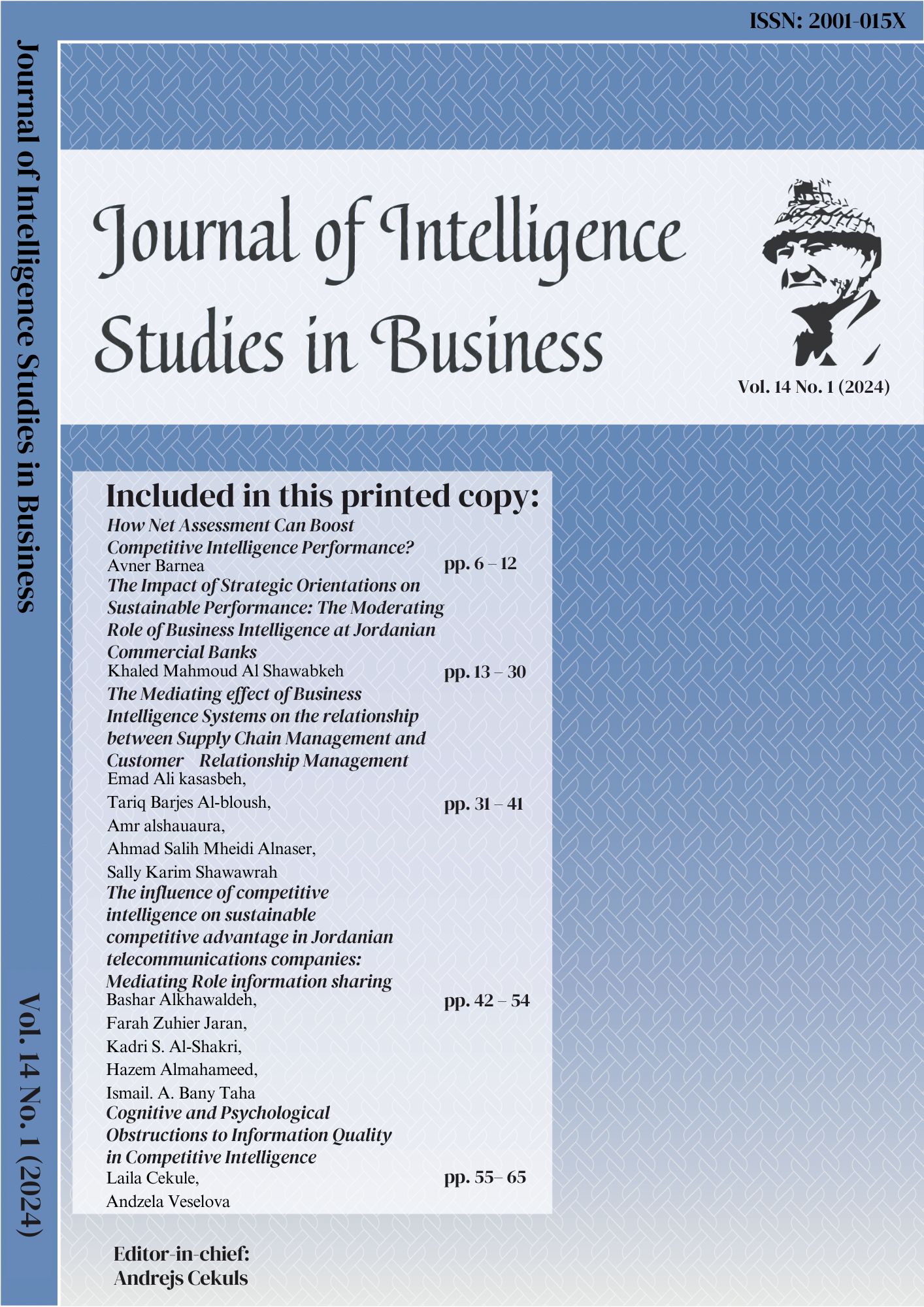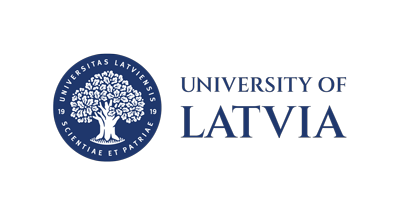How Net Assessment Can Boost Competitive Intelligence Performance?
DOI:
https://doi.org/10.37380/jisib.v14.i1.2485Keywords:
Net assessment, strategic surprises, competitive intelligence, business strategyAbstract
In the business sector, Competitive Intelligence (CI) units are often responsible for overseeing the assessment delivered to the top executives regarding competitors' threats and opportunities and comprehending the meaning of external changes in the related markets. Unfortunately, there is insufficient attention to how these units can be more valuable and help corporations avoid strategic surprises. This paper offers a new concept that will create better value using the Net Assessment approach in corporations.
The approach, as detailed in my recent book, 'We Never Expected That: A Comparative Study of Failures in National and Business Intelligence” (Barnea, 2021), illustrates the practicality of transplanting strategies from the national intelligence sphere to bolster business intelligence. It underscores the potential for cross-pollination of ideas and improvement between these two domains.
Net Assessment, a robust framework for analyzing national security threats, has been a cornerstone of the United States defense establishment's strategy for years, yielding significant results. This paper advocates for its integration into the toolkit of CI units and executives, underscoring its potential to deliver substantial performance enhancements for corporations.
References
Barnea, A. (2016). Study of Competitive Intelligence in Israel: 2016 Update. Journal of Intelligence Studies in Business. Vol. 6, No. 2, pp. 5-16 https://ojs.hh.se/index.php/JISIB/article/view/156 DOI: https://doi.org/10.37380/jisib.v6i2.169
Barnea, A. (2022). Measuring the value of Intelligence in Business. Competitive Intelligence Magazine, Vol, 22, January.
Barnea, A. (2021). We Never Expected That: A Comparative Study of Failures in National and Business Intelligence. New York, Lexington Books.
Bracken, P. (2006). Net assessment: a practical guide. Parameters, 36, no.1, p. 91, 97. DOI: https://doi.org/10.55540/0031-1723.2285
Cameron, K. (2020). As the US Market Exploded, Japan Took Over. Cycle World, September 4. https://www.cycleworld.com/story/bikes/as-the-us-market-exploded-japan-took-over/
Cavallo, A. Sanasi, S. Ghezzi, A. & Rangone, A. (2021). Competitive intelligence and strategy formulation: connecting the dots. Competitiveness Review, Vol. 31 No. 2, pp. 250-275. https://doi.org/10.1108/CR-01-2020-0009 DOI: https://doi.org/10.1108/CR-01-2020-0009
Daft, R. (2012). Organization Theory and Design. USA, South-Western Cengage Learning, p. 157.
Davison, L. (2001). Measuring competitive intelligence effectiveness: Insights from the advertising industry. Competitive Intelligence Review, Volume 12, Issue 4, pp. 25–38. DOI: https://doi.org/10.1002/cir.1029
Ezigbo, C. & Uduji, J. (2013). Manage Competitive Intelligence for Strategic Advantage—European Journal of Business and Management, Vol.5, No.3.
Fuld, L. & Chodnowsky, M. (2010). The Art of Anticipating Disruptions. Fuld and Co.
Fuld, l. (2010). The Secrets Language of Competitive Intelligence. Dog Ear Publishing, Indianapolis, pp. 19–27.
Grant, R. (2005). Contemporary Strategic Analysis. Blackwell Publishing, p. 12.
Grove, A. (1997). Only the Paranoid Survive. Profile Books, pp. 2–3, 18–23.
Hoffman, F. (2021). Net Assessment and Military Strategy: Retrospect and Prospective Essays. Joint Forces Quarterly, no. 102. https://ndupress.ndu.edu/Media/News/News-Article-View/Article/2680725/net-assessment-and-military-strategy-retrospective-and-prospective-essays/
Jaworski, B. Macinnis, D. & Kohli, A. (2002). Generating Competitive Intelligence in Organizations. Journal of Market-Focused Management, 5 (4), pp. 279-307. DOI: https://doi.org/10.1023/B:JMFM.0000008071.19917.36
Kahneman, D. (2013). Thinking. Fast and Slow. Tel Aviv, Kinneret Matar, pp. 85-86. Hebrew edition.
McGonagle, J. & Misner-Elias, M. (2016). The Changing Landscape of Competitive Intelligence: Two Critical Issues Invested. Salus Journal, No. 1 Issue 4.
McGonagle, J.J. & Vella, C.M. (1999). The Internet age of competitive intelligence. London: Quorum Books. DOI: https://doi.org/10.5040/9798216975120
McKinsey Global Survey Results, (2008). How Companies Can Understand Competitor's Moves: McKinsey Global Survey results. McKinsey Quarterly, January 1. https://www.mckinsey.com/capabilities/strategy-and-corporate-finance/our-insights/how-companies-can-understand-competitors-moves-mckinsey-global-survey-results
Reeves, M. Levin, S. & Ueda, D. (2016). The Biology of Corporate Survival. Harvard Business Review, January -February. The Biology of Corporate Survival (hbr.org)
Saffo, P. (2007). Six Rules for Effective Forecasting. Harvard Business Review, July-August, 2007. https://hbr.org/2007/07/six-rules-for-effective-forecasting
Spevacek, A. (2017). Net assessment: Overview and assessment. USAID Knowledge Services Center, chrome extension://efaidnbmnnnibpcajpcglclefindmkaj/https://pdf.usaid.gov/pdf_docs/PA00SXMH.pdf
Stauffer, D. (2003). The Power of CI. Harvard Management Update, U0310C, October.
Tanir, B., (2023). Competitive Intelligence: Your Secret Weapon for Business Growth. Forbes, November 13. www.forbes.com/sites/forbestechcouncil/2023/11/13/competitive-intelligence-your-secret-weapon-for-business-growth/?sh=34f326dd3df3
Tett, G. (2015). The Silo Effect. London: Little Brown, p. 11.
Webb, A. (2024). Bringing True Strategic Foresight Back to Business. Harvard Business Review, January 12, https://hbr.org/2024/01/bringing-true-strategic-foresight-back-to-business.
Downloads
Published
Issue
Section
License
Copyright (c) 2024 Journal of Intelligence Studies in Business

This work is licensed under a Creative Commons Attribution-NonCommercial-NoDerivatives 4.0 International License.
Authors who publish with this journal agree to the following terms:
- Authors retain copyright and grant the journal right of first publication with the work simultaneously licensed under a Creative Commons Attribution License that allows others to share the work with an acknowledgement of the work's authorship and initial publication in this journal.
- Authors are able to enter into separate, additional contractual arrangements for the non-exclusive distribution of the journal's published version of the work (e.g., post it to an institutional repository or publish it in a book), with an acknowledgement of its initial publication in this journal.
- Authors are permitted and encouraged to post their work online (e.g., in institutional repositories or on their website) prior to and during the submission process, as it can lead to productive exchanges, as well as earlier and greater citation of published work (See The Effect of Open Access).








